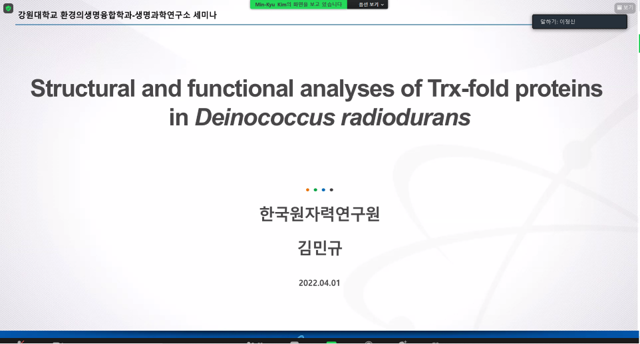생명과학연구소 특별세미나_김민규 박사님(한국원자력연구원)
페이지 정보
작성자 : 관리자 날짜 : 작성일22-05-31 09:36 조회 : 6,683회첨부파일
본문
일시: 2022. 4. 1 (금) 오후 1시
zoom link: https://kangwon-ac-kr.zoom.us/j/98667909058?pwd=cFFwZmExWkNyUnAydUFKMUF4S2lRZz09

제목: Structural and functional analyses of Trx-fold proteins in Deinococcus radiodurans
Maintaining a proper redox state in the extracellular or intracellular environment is critical for a variety of cellular processes.
One of the main protein systems that regulate the thiol/disulfide redox balance in the cytoplasm are the NADPH-dependent
thioredoxin (Trx) system, composed of thioredoxin reductase (TrxR)/Trx/NADPH. Trx is a small protein of approximately
12 kD with a highly conserved CXXC motif in its active site, which reduces disulfide bonds in a wide range of proteins.
Trx is characterized by a common three-dimensional structure consisting of four α-helices and five β-sheets, wherein, its
active site CXXC motif, located after the β2-sheet, forms the N-terminal portion of α2. Trx2 contains an additional Nterminal domain including two CXXC motifs responsible for zinc binding. It was proposed that the zinc-finger domain of
Trx2 may mediate protein-protein interactions. During the catalytic cycle, the two cysteines in the active site CXXC motif
exist in the form of a reduced dithiol or an oxidized disulfide alternately. When Trx reduces a disulfide bridge of its target
proteins, it is oxidized and the disulfide in Trx is reduced back to the thiol state by by a NADPH-dependent thioredoxin
reductase (NTR).
The Trx system is important for cellular defense against oxidative stress because the oxidative stress promotes disulfide
bond formation in redox-sensitive proteins, thereby functionally modulating these proteins. Furthermore, Trx directly
reduces H2O2 by providing reducing equivalents to peroxiredoxins (Prxs) and functions as a singlet oxygen quencher, a
hydroxyl radical scavenger, and a hydrogen donor for peroxidases.
Deinococcus radiodurans is extremely resistant to ionizing radiation (IR), UV, desiccation, and oxidizing agents. Cellular
exposure to IR increases various reactive oxygen species (ROS) and subsequently causes oxidative damage to DNA, lipids,
and proteins. D. radiodurans has evolved strategies to reduce endogenous ROS production, such as lowering the number of
respiratory chain enzymes, importing peptides and amino acids from the environment, and inducing the glyoxylate bypass
of the tricarboxylic acid cycle following IR. In this study, we investigate the structures and biochemical functions of three
Trx-fold containing proteins (Trx2, NrdH, DsbA in D. radiodurans to unveil the relationship between these proteins and the
oxidative stress resistance of D. radiodurans.








